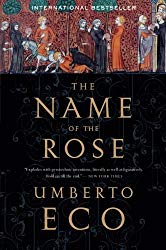“The Name Of The Rose” is on the surface a medieval murder-mystery novel by Umberto Eco (translated into English by William Weaver). When you read it, you realize that it is also expounds on history, theology, philosophy, logic, politics, etc. all the while having an entertaining plot. It provides a nice insight into monastic life in 14th century Europe and the struggles between the church, the state, and the sundry factions of Christianity fighting with each other for dominance at the time. It was also made into a (not so successful) movie of the same name in 1986 featuring Sean Connery.
The novel is set in the year 1327. Its events take place over the course of seven days in a fictional Benedictine monastery in an abbey located somewhere in Northern Italy. It is written in the form of the memoirs of a Benedictine novice travelling with his Franciscan master to the abbey. The book is divided into nine parts: the middle seven parts correspond to each of the seven days they spend in the abbey and are sandwiched between a prologue and an epilogue. Each of these seven parts is then sub-divided into chapters corresponding to the liturgical hours during a day. This structure, combined with the fact that people keep dying mysteriously throughout the book, makes the book a bit more manageable than what would have been the case in the face of all the expositions and the untranslated Latin.
Every now and then, some of the characters end up debating (very, very impressively, I must admit) over various minutiae — Is laughter licit for a monk? Was Christ really poor? Should all heretics be clubbed together? Et cetera. To the layperson these questions might appear rather arcane and even pointless, but their resolution determined the behavior of the church and the life of the monks, so they were actually quite significant. The characters quote various authorities and references to bolster their respective points and I could not help but wonder just how much research was needed on part of the author to create such credibly-erudite dialogues. Very impressive indeed. However, these debates (and the expositions on such points by some of the characters) do become a bit tedious at times and hamper the readability of the book.
Another deterrent to the readability of the book is the copious amount of untranslated Latin that is present throughout the book. Why do some authors and publishers assume that every reader of their book would know how to read Latin, that too Ecclesiastical Latin? (I have complained before about this, in fact, while reviewing another novel by Umberto Eco.) Given that many of the monks and priests in the book are shown to have come from various parts of Europe, they would quite probably be talking to each other in Latin anyway. Why then are only some of the passages and fragments of sentences in Latin when the rest of the book is, in effect, a translation from Latin? I thus found all the Latin in this book gratuitous and quite irritating.
All that aside, the book turned out to be fairly entertaining and quite insightful at the same time, so I am happy to have read it. I recommend that you read it, especially if you are interested in history, theology, philosophy, or are just fascinated by medieval Europe in general (or how monks copied and illustrated books in a Scriptorium in particular). I am now tempted to watch the eponymous movie, especially because it has Sean Connery.
